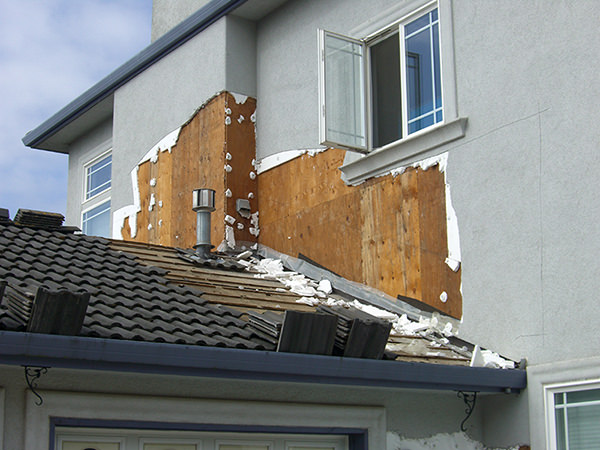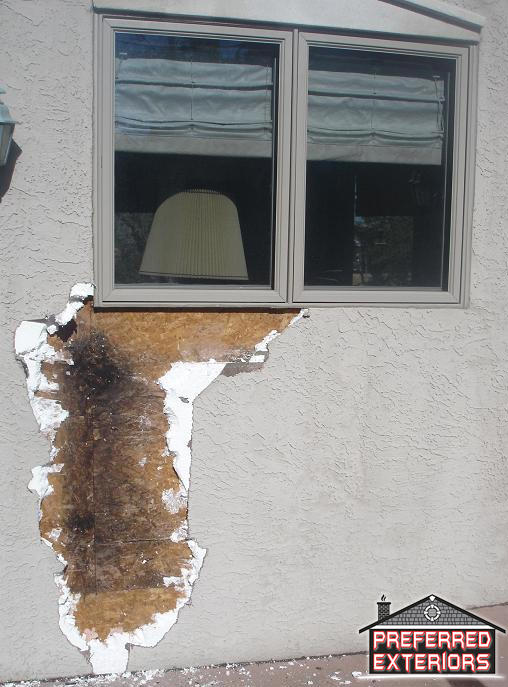EIFS Dryvit synthetic stucco inspections & replacement siding contractors serving Camas, Ridgefield and all Clark County.
EIFS stands for Exterior Insulation Finish System and is sometimes called Dryvit. It is most common on higher end homes in Camas and Ridgefield Washington. This form of synthetic stucco primarily fails because there is almost always NO moisture barrier protecting your wood sub wall structure when rain gets in. There is never window and door membrane flashing behind the stucco. Although doors are often protected somewhat under overhangs windows usually aren’t, especially on any 2 story home. When rain trickles in it gets trapped behind the foam and the water begins to mold and rot the wood substructure underneath the building envelope. The excessive rain and moisture here in the NW metro area gets trapped behind the foam backing and the wood sheathing it is attached to.
Are you purchasing or selling a home with EIFS synthetic stucco?
I have been a siding contractor and inspector for 3 decades and can honestly and factually say I’ve inspected more EIFS synthetic stucco than anybody in town. Period. Unlike young salesman in this industry I will tell you the truth from all my experience and not sell you what you don’t need. Many young inexperienced millennial salesmen will try to sell you with fear. I won’t. With 30 years of experience inspecting for buyers and sellers, my inspections and reports are highly comprehensive generally taking 4-5 hours in detailed diagnosis and putting together all the analysis in my discovery reports.
Do you work with Realtors?
Yes. A lot of them and know many on a first name basis. I work with selling agents and buying agents. I always prefer my client AND their realtor to be at my inspections. I will give you a crash course on what to look for as my inspections are extremely detailed and I personally love educating people on subjects of my expertise.
If needed, can you provide a detailed bid?
Absolutely, and it will help you more than you can imagine in the selling or purchasing of the property. If the structure and building envelope doesn’t have problems, unlike many young unseasoned commission salesmen, I will be the first to let you know. I won’t take advantage of your situation.

In your EIFS synthetic stucco inspections can you check for flashing or a moisture barrier?
 There is rarely window membrane flashing behind the windows but I can often tell you exactly what type of moisture barrier there is IF one exists at all. But remember, there is also rarely any moisture barrier which is THE big problem with this synthetic stucco in our rainy climate. Unlike most younger inexperienced EIFS stucco siding contractors, I will tell you the truth on your structure and not sell you fear. As stated earlier the failure to install proper flashing systems to protect the “building envelope” is THE common problem. Look at the picture to the right. There is no moisture barrier. This is one of the main problems. Often at my detailed inspections, I can verify IF a moisture barrier exists in areas but it is impossible to verify how much of the structure it is actually on. I also show my client and the realtor where flashing should be and if any high risk moisture areas exist. I ask they both follow me as I move around the house.
There is rarely window membrane flashing behind the windows but I can often tell you exactly what type of moisture barrier there is IF one exists at all. But remember, there is also rarely any moisture barrier which is THE big problem with this synthetic stucco in our rainy climate. Unlike most younger inexperienced EIFS stucco siding contractors, I will tell you the truth on your structure and not sell you fear. As stated earlier the failure to install proper flashing systems to protect the “building envelope” is THE common problem. Look at the picture to the right. There is no moisture barrier. This is one of the main problems. Often at my detailed inspections, I can verify IF a moisture barrier exists in areas but it is impossible to verify how much of the structure it is actually on. I also show my client and the realtor where flashing should be and if any high risk moisture areas exist. I ask they both follow me as I move around the house.
How is EIFS Synthetic Stucco installed and removed?
The 2 ways EIFS synthetic stucco is installed is being glued on OR put on with round plastic grommet style fasteners. (see picture to the right) It has to be scored and meticulously scraped off with flat shovels. It is extremely difficult to contain the thousands of tiny foam particles. Although most EIFS manufacturers have detailed installation instructions, these are often ignored by installers since few siding companies have experience installing EIFS stucco in the Southern Washington area. EIFS simply never should have been brought to our climate and was often used by builders who migrated here from California in the 80’s.

In your inspections, can you show us where rain gets in creating damage?
Yes. I will point out all the potential areas as I inspect the structure and building envelope. When rain penetrates ANY cracks or openings it gets behind the EIFS. it is unable to evaporate because of the constant moisture we get. The moisture attacks the framing, wood sheeting and studs simply because it can’t escape or drain out. This leads to dry rot and potential toxic mold problems because of the constant rain we have here in the NW. Mold and dry rot damage can often cost tens of thousands of dollars.
EIFS Gallery
Why do Carpenter ants like EIFS Synthetic Stucco so much?
At my inspections I check for carpenter ants but they won’t come out much in the rain. They come out when it is extremely hot – generally over 90 degrees. They are by far the worst insect problem because they nest in soft moist wood. If you live in the woods this can be amplified but they will go anywhere there is soft moist wood. They are VERY large black ants. When my children were young I would pay them a nickel for every carpenter ant they killed simply because I often saw the damage they can do structurally as I was replacing Lp siding or Eifs stucco. If you leave a dead carpenter ant out overnight, the other ones will take the dead ant back to their nest. It usually won’t be there in the morning.
Does an Infrared thermal imaging moisture meter really work?
No, but it’s a fancy word so inexperienced siding contractors like throwing it around because it makes them look technical. Here’s why they aren’t truly efficient. You would have to literally run the imager over EVERY square inch of the home. (see the image above with sheeting damage under the wall) This alone would cost each homeowner a fortune in cost and time because it would take so long to do. You would be spending thousands of dollars just for an inspection. That’s crazy talk. The other big problem is if there is no moisture in THAT specific area and at THAT specific moment, it won’t read accurately thereby giving the homeowner a false inaccurate reading and a false sense of security. So if you are using the imager in the summer you are going to get much less readings because over time, the wood sheeting underneath will eventually dry out but that wont tell you if there is dry rot from what rain has accumulated over the 8-10 wet months of the year. Thermal imagers only read heat variances, NOT moisture comment. The problem with EIFS synthetic stucco is specifically the moisture content building up creating rot. As the owner/operator of Preferred Exteriors I will personally perform your inspection. I use intrusive digitally calibrated moisture meters that read the exact moisture content of what they touch. They what we want to know. How much moisture is behind the stucco.


Has EIFS synthetic stucco been in lawsuits?
 Yes. EIFS stucco has been in nationwide class action lawsuits from rain, moisture buildup and mold growth. A perfect example is the picture to the right where a random piece of EIFS synthetic stucco was cut out showing wet subwall underneath and rot. As usual there is no moisture barrier at all. This is THE major problem with this faulty product for our climate. General contractors who came here to the northwest from California during the building boom of the 80’s switched to EIFS because it was marketed as an easy install with unskilled or semi-skilled labor and supposedly would not crack like regular stucco. Many general contractors severely cut corners by using unqualified cheap day laborers. Thousands of EIFS synthetic stucco installs were therefore noncompliant and allowed severe rain intrusion creating mold and rot over time needing very costly mold remediation. The EIFS big shots consistently tried to point the finger and place the blame on the general contractors who should have known the Northwest gets a massive amount of rain. Much of the Eifs synthetic stucco is in the Camas and Fishers Landing area although other pockets do exists in higher end areas.
Yes. EIFS stucco has been in nationwide class action lawsuits from rain, moisture buildup and mold growth. A perfect example is the picture to the right where a random piece of EIFS synthetic stucco was cut out showing wet subwall underneath and rot. As usual there is no moisture barrier at all. This is THE major problem with this faulty product for our climate. General contractors who came here to the northwest from California during the building boom of the 80’s switched to EIFS because it was marketed as an easy install with unskilled or semi-skilled labor and supposedly would not crack like regular stucco. Many general contractors severely cut corners by using unqualified cheap day laborers. Thousands of EIFS synthetic stucco installs were therefore noncompliant and allowed severe rain intrusion creating mold and rot over time needing very costly mold remediation. The EIFS big shots consistently tried to point the finger and place the blame on the general contractors who should have known the Northwest gets a massive amount of rain. Much of the Eifs synthetic stucco is in the Camas and Fishers Landing area although other pockets do exists in higher end areas.


































